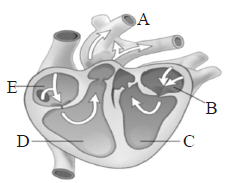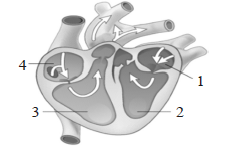Please refer to Body Fluids and Circulation Class 11 Biology Important Questions with solutions provided below. These questions and answers have been provided for Class 11 Biology based on the latest syllabus and examination guidelines issued by CBSE, NCERT, and KVS. Students should learn these problem solutions as it will help them to gain more marks in examinations. We have provided Important Questions for Class 11 Biology for all chapters in your book. These Board exam questions have been designed by expert teachers of Standard 11.
Class 11 Biology Important Questions Body Fluids and Circulation
Objective Questions
Question. Blood a special type of connective tissue
(a) Consists of fluid matrix
(b) Has formed elements
(c) Is the most commonly used body fluid by most of the higher organisms
(d) All
Answer
D
Question. The amount of water present in blood plasma is
(a) 99%
(b) 90-92%
(c) 10%
(d) 55%
Answer
B
Question. Match the following
| Column – I | Column – II |
| A. Fibrinogen | I. Defence mechanism |
| B. Globulins | II. Osmotic balance |
| C. Albumins | III. Coagulation of blood |
Options :
(a) A – III, B – I, C – II
(b) A – I, B – III, C – II
(c) A – II, B – I, C – III
(d) None of the above
Answer
A
Question. Which of the following statement is false?
(a) Erythrocyte are least abundant of all cells in blood
(b) The number of RBCs in adult man per mm3 of blood is 5 million to 5.5 million
(c) RBC are formed in the red bone marrow in the adults
(d) RBCs are enucleate in most of the mammals
Answer
A
Question. What is the amount of hemoglobin present in 100 ml of human blood?
(a) 45g
(b) 18-20g
(c) 12-16g
(d) 10-12g
Answer
C
Question. All of the following statements are correct about WBCs except
(a) They are nucleate and there is least constancy in shape
(b) They are lesser in number
(c) They are generally short lived
(d) They help in blood clotting
Answer
D
Question. Match the column
| Column – I | Column – II |
| A. Neutrophils | I. 20 – 25% |
| B. Basophils | II. 2 – 3% |
| C. Monocytes | III. 6 -8% |
| D. Eosinophils | IV. 0.5 – 1% |
| E. Lymphocytes | V. 60 – 65% |
Options :
(a) A – V, B – IV, C – III, D – I, E – II
(b) A – I, B – II, C – III, D – V, E – IV
(c) A – V, B – IV, C – III, D – II, E – I
(d) A – II, B – IV, C – I, D – III, E – I
Answer
C
Question. Note the following blood vessels
A. Arteriole
B. Capillary
C. Aorta
D. Artery
E. Vein
F. Venule
Choose the correct path that lists the blood vessels in order, blood passes through them as it leaves the heart, travels and returns to heart.
(a) C, D, B, A, E, F
(b) C, D, A, B, F, E
(c) D, C, A, B, E, F
(d) D, C, B, A, E, F
Answer
B
Question. 1mm3 blood has how many blood platelets
(a) 150000-350000
(b) 1.5 million to 3.5 milliion
(c) 1500-3000
(d) 10-15 lacs
Answer
A
Question. ABO blood group is based on the presence or absence of _____ surface antigens
(a) 2
(b) 3
(c) 6
(d) 12
Answer
A
Question. Which one of the following blood vessel is without valves?
(a) Artery
(b) Pulmonary aorta
(c) Vein
(d) Systemic aorta
Answer
A
Question. The opening of auricles into ventricles on the right side is guarded by which valve?
(a) Tricuspid
(b) Bicuspid
(c) Semilunar
(d) Mitral valve
Answer
A
Question. ‘Bicuspid’ term is applied to
(a) a valve in heart and a bone of pelvic girdle.
(b) a muscle in upper arm and a valve in heart.
(c) a valve in heart and tooth surface.
(d) a valve in heart.
Answer
C
Question. Which of the following has the thickest walls?
(a) Right ventricle
(b) Left ventricle
(c) Right auricle
(d) Left auricle
Answer
B
Question. Sinu-atrial node in human heart is embedded in the wall of
(a) sinus-venosus
(b) interatrial septum
(c) right atrium
(d) atrioventricular septum
Answer
C
Question. What is the function of valve?
(a) To prevent blood from flowing into the aorta.
(b) To push blood into the ventricle.
(c) To push blood into the aorta.
(d) To prevent backflow of blood into the left ventricle.
Answer
D
Question. In mammals the blood from the right ventricle goes to
(a) systemic aorta
(b) precavals
(c) truncus arteriosus
(d) pulmonary aorta
Answer
D
Question. The first heart sound is
(a) ‘LUBB’ sound produced at the end of systole.
(b) ‘DUP’ sound produced at the end of systole.
(c) ‘LUBB’ sound produced at the beginning of systole.
(d) ‘DUP’ sound produced at the beginning of systole.
Answer
C
Question. Cardiac cycle in man takes about
(a) 0.5 seconds
(b) 1.0 second
(c) 1.2 seconds
(d) 0.8 seconds
Answer
D
Question. ‘P’ wave of ECG occurs before the
(a) onset of ventricular contraction.
(b) end of arterial contraction.
(c) beginning of atrial contraction.
(d) none of the above.
Answer
C
Question. The largest artery in the body is
(a) aorta
(b) precaval
(c) vena cava
(d) pulmonary artery
Answer
A
Question. Which circulation provides nutrients and oxygen to cardiac muscle tissue?
(a) Pulmonary circulation
(b) Systemic circulation
(c) Lymphatic circulation
(d) Coronary circulation
Answer
D
Question. Which structures are directly involved in the “systemic circulation”?
(a) Superior vena cava, right ventricle and left ventricle.
(b) Right ventricle, pulmonary arteries and left atrium.
(c) Left ventricle, aorta and inferior vena cava.
(d) Right atrium, pulmonary trunk and left ventricle.
Answer
C
Question. Which of the following parts of heart possess semilunar valves?
(i) Aorta
(ii) Vena cava
(iii) Pulmonary artery
(iv) Pulmonary vein
(a) (i) and (iii)
(b) (i), (ii) and (iii)
(c) (ii) and (iii)
(d) (i), (iii) and (iv)
Answer
A
Question. Pulse beat is measured from
(a) capillaries
(b) arteries
(c) veins
(d) nerves
Answer
B
Question. Hardening of the arteries due to deposition of cholesterol is called
(a) thrombosis
(b) atherosclerosis
(c) rhinitis
(d) angina
Answer
B
Statement Type Question
Question. Which of the following statements is/are correct for blood group?
(i) Blood group O is universal donor.
(ii) Blood group AB is universal acceptor.
(iii) Blood group A contains antigen B and anti-A antibodies.
(iv) Blood group B contains antigen B and anti-A antibodies.
(a) Only (i) and (ii).
(b) Only (i), (ii) and (iii).
(c) Only (i), (ii) and (iv).
(d) Only (i), (iii) and (iv).
Answer
C
Question. Which of the following statements is correct regarding pulmonary artery ?
(a) It carries deoxygenated blood from heart to lungs.
(b) It carries deoxygenated blood from lungs to heart.
(c) It carries oxygenated blood from heart to lungs.
(d) It carries oxygenated blood from lungs to heart.
Answer
A
Question. Which of the following statement is correct regarding lymph?
(a) It transports oxygen to brain.
(b) It transport CO2 to lungs.
(c) It returns interstitial fluid to blood.
(d) It returns RBCs and WBCs to lymph nodes.
Answer
C
Question. Which of the following statement is correct regarding blood cells?
(a) A healthy individual has 12 – 16 gms of haemoglobin in every 200ml of blood.
(b) RBC as an average life span of 120 days after which they are destroyed in the spleen.
(c) Neutrophils and basophils are phagocytic cells which destroy foreign organisms entering the body.
(d) A reduction in the number of WBC leads to clotting disorders which will lead to excessive loss of blood from the body.
Answer
B
Assertion/Reason Type Questions
In the following questions, a statement of Assertion is followed by a statement of Reason.
(a) If both Assertion and Reason are true and the Reason is the correct explanation of the Assertion.
(b) If both Assertion and Reason are true but the Reason is not the correct explanation of the Assertion.
(c) If Assertion is true but Reason is false.
(d) If both Assertion and Reason are false.
Question. Assertion : Lub is a heart sound which is produced during each cardiac cycle.
Reason : It is associated with the closure of the tricuspid and bicuspid valves.
Answer
B
Question. Assertion : Blood pressure is arterial blood pressure.
Reason : Blood pressure is measured by sphygmomanometer.
Answer
B
Question. Assertion : Blood coagulates in uninjured blood vessels.
Reason : Uninjured blood vessels release an anticoagulant heparin.
Answer
D
Question. Assertion :When there is a fall in the blood pressure due to loss of blood volume, this is compensated by vasoconstriction of veins.
Reason : Veins hold the extra amount of blood which can be shifted to the arteries as required.
Answer
A
Diagram Type Questions
Question. Given below is the ECG of a normal human.

Which one of its components is correctly interpreted?
(a) Peak P and Peak R together – Systolic and diastolic blood pressures
(b) Peak P – Initiation of left atrial contraction only
(c) Complex QRS – One complete pulse
(d) Peak T – Initiation of total cardiac contraction
Answer
C
Question. In the given diagram of human heart the mitral valve is located between which two parts of the heart?

(a) D and E
(b) B and C
(c) D and C
(d) E and B
Answer
B
Question. Refer the given figure of human heart and identify the chamber (marked as 1, 2, 3 & 4) which receives most of the blood returning from the brain.

(a) I- Left atrium
(b) II- Left ventricle
(c) III- Right ventricle
(d) IV- Right atrium
Answer
D
Question. The given figure represents diagrammatic presentation of an ECG. Each peak in the ECG is identified with a letter from P to T that corresponds to a specific electrical activity of the heart.
Which of the following letter shows the incorrect activity of heart?

(a) QRS – Depolarization of the ventricles
(b) R wave – Marks the beginning of the systole.
(c) P- Electrical excitation (or depolarization) of the atria
(d) T wave – Return of the ventricles from excited to normal state (repolarization).
Answer
B
Critical Thinking Type Questions
Question. What is true about leucocytes ?
(a) Their sudden fall in number is indication of blood cancer.
(b) These are produced in thymus.
(c) These are enucleated.
(d) These can squeeze out through the capillary walls.
Answer
D
Question. If nerves of heart are cut, then heart will
(a) beat rhythmically
(b) stop
(c) beat arhythmically
(d) shrink
Answer
A
Question. The blood returning to the heart through pulmonary vein has more
(a) RBC
(b) haemoglobin
(c) oxygen
(d) nutrient
Answer
C
Question. What happens when the pacemaker becomes nonfunctional?
(a) Only the auricles will contract rhythmically.
(b) The cardiac muslces do not contract in a coordinated manner rhythmically.
(c) Only ventricles will contract rhythmically.
(d) Auricles and ventricles contract simultaneously.
Answer
B
Question. A drop of each of the following, is placed separately on four slides. Which of them will not coagulate?
(a) Whole blood from pulmonary vein
(b) Blood plasma
(c) Blood serum
(d) Sample from the thoracic duct of lymphatic system
Answer
C


